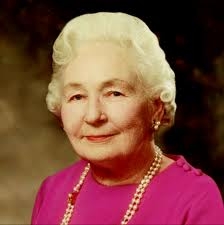Camilla Eyring Kimball
Camilla Eyring Kimball was born December 7, 1894, in Colonia Juarez, in the Mormon colonies of northern Mexico. Her father left on a mission to Germany when she was almost three years old and the family struggled financially in his absence. She taught Primary and Sunday School since she was fifteen and got a feeling she would like to be a teacher.
Camilla fled with her family to El Paso, Texas, in 1912 due to revolution in Mexico and she lost most of her belongings. Her uncle Carl Eyring invited her to come to Provo to live when she was seventeen. After she arrived, she found a job packing peaches for two weeks to earn a few dollars. Her parents were unable to support her, she felt like a charity case in her uncle’s home, and her clothes were not suitable for the style and climate of Provo—all of which made her unhappy. But she did well in school.
The next summer, she and her sister Mary spent the summer with an invalid friend of their mother’s, and Camilla was able to earn money doing household chores. She also earned money by doing washing and ironing for other women. Her family had moved to Arizona, and Camilla completed her senior year and concurrently took college-level home economics courses so she could teach. After her graduation she visited her family in Arizona for the summer—and met Spencer W. Kimball—and then began teaching home economics at Millard Academy in Hinckley, Utah. She was by this time nineteen years old. The following summer, she had earned enough money to take summer classes at the University of California, Berkeley. She worked one more year at Millard Academy, then attended Utah Agricultural College. She worked in Salt Lake during the summer of 1917 as a servant to earn money for a train ticket to Arizona for a teaching position at Gila Academy in Thatcher in the fall. She didn’t want her friends to know she was a servant, however, so she told them “I am getting practical experience for my work of teaching home economics.”[1]
By this time, she was almost twenty-three years old. She wanted to marry, but she also had plans to become a hospital dietitian and wanted to save her teaching money so she could attend Johns Hopkins University. She again met Spencer Kimball, this time on Thatcher’s Main Street as she was waiting for a bus. They became better friends in the two weeks before he left for school in Provo, but when he was drafted, he returned home in October and their relationship intensified. They decided to marry before he went into the service. The contract with Gila Academy would not allow her enough time off to travel to Salt Lake City to marry in the temple, so they were married on November 16, 1917, in Pima, Arizona. Spencer never had to report for military duty, and as soon as her commitment to the Academy was concluded, they drove to Salt Lake to be sealed. By this time, she was pregnant with their first child. They settled in Safford, Arizona, and eventually had four children. She continued to take classes every year until their travel schedule made it impossible — he was sustained to the Quorum of the Twelve Apostles in 1943.
It was difficult for Camilla to move to Utah — Arizona had been their only home, and she was suffering with an illness at the time; but they were devoted to serving the Lord. He became president of the Church in December 1973.
She continued to learn her entire life. “We need to be always learning. A person keeps from getting stale by having some objective, by reading, writing and talking in pursuit of a plan.”[1] Her husband shared her devotion to learning. As president of the Church, he encouraged women to become “full contributing partners” in their marriages.[2]
She earned Exemplary Womanhood awards from both Brigham Young University and Ricks College. She is remembered for her motto: “Never suppress a generous thought.”[3] Camilla died on September 20, 1987; her husband had died two years earlier on November 5, 1985.
In her biography, her husband wrote, in part: “We have wept together and we have laughed together. We have seen the sublime and have suffered the grotesque. Our life has been full of fun in spite of all the sad and serious things. We have danced; we have sung; we have entertained; we have loved and been loved. With a wife like Camilla Eyring, life becomes inclusive, full, and abundant.”[2]
